| What: | Creation of the chief human capital officer role and the CHCO Council |
| When: | The Chief Human Capital Officers Act was passed in 2002 as part of the Homeland Security Act |
| Why it matters: | The CHCO role transformed the way agencies approach human capital management, while the formation of the CHCO Council propelled HR leaders to think of workforce management as a governmentwide goal, rather than being siloed at individual agencies. |
Politics
How human capital got a seat at the federal leadership table
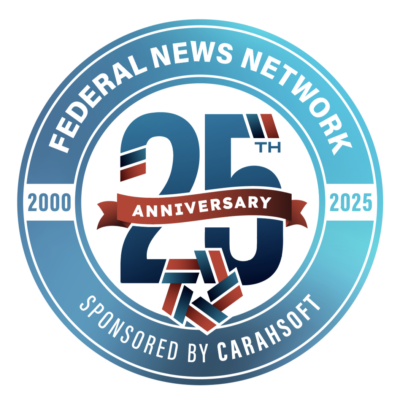

The creation of a key leadership role in 2002 transformed how agencies manage what many say is the federal government’s most critical asset: its people.
Human capital challenges in government have existed for decades. But in the late 1990s and early 2000s, converging attempts to address the issue began to take shape. The Office of Personnel Management was looking to enhance the role of HR in government. The Government Accountability Office was beginning to elevate conversations on human capital management. And when President George W. Bush took office in January 2001, the first pillar of his administration’s President’s Management Agenda was about the strategic management of human capital.
The human capital push was coming from within Congress too. The late Sen. George Voinovich (R-Ohio) advocated for years for federal workforce reforms. In congressional testimony from March 2000, Voinovich went so far as to say the government was facing a human capital “crisis” — one that needed to be “aggressively addressed.”
At the time, though, there was no clearly defined leadership position to manage the workforce within each agency. Many agencies had HR directors, but that role didn’t have standardized responsibilities governmentwide. And while there were pockets of collaboration among HR leaders, there was no singular sounding board to bring human capital challenges to the forefront of federal strategy.
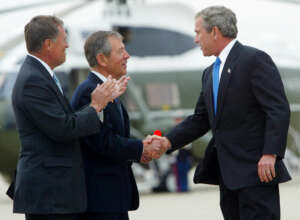 In 2003, President George W. Bush, right, arrives at Wright Patterson Air Force Base and is greeted by Sen. George Voinovich (R-Ohio), center, and Rep. Mike Oxley, (R-Ohio), in Dayton, Ohio. (AP Photo/Pablo Martinez Monsivais)
In 2003, President George W. Bush, right, arrives at Wright Patterson Air Force Base and is greeted by Sen. George Voinovich (R-Ohio), center, and Rep. Mike Oxley, (R-Ohio), in Dayton, Ohio. (AP Photo/Pablo Martinez Monsivais)
Still, what Voinovich and many others saw as a critical gap in human capital management wasn’t immediately taken up. Instead, it took the terrorist attacks on Sept. 11, 2001, for Congress to fully respond to the issue. The shock of the major national security crisis, in part, led to the passage of the Chief Human Capital Officers Act — wrapped within the 2002 Homeland Security Act. Among the larger government restructuring that came from the landmark legislation, it also created the chief human capital officer role — a key position tasked with ensuring agencies had the right people in place to fully deliver each agency’s mission.
“So many things have gone wrong recently in the federal government because we lacked the right people in the right job,” Voinovich, who led the charge on adding the CHCO Act into the bill, wrote in a July 2002 press release.
Regardless of whether the CHCO position’s creation was intentionally connected to the need for a stronger national security presence in the U.S., or whether the Homeland Security Act was simply a must-pass vehicle that could ensure the role’s establishment, it ultimately heightened the authority of human capital experts in government leadership.
“HR had always been a really important function in the government, but when you compared it to the chief financial officers, the CIOs, even the chief acquisition officers, human capital didn’t have a complete seat at the table,” John Salamone, a long-time federal human capital leader, said in an interview. “The real push was to promote this notion of elevating human resources, giving them a seat at the table with other C-suite functions so they can be on an even playing field.”
The tremendous tasks of the agency CHCO
Under the 2002 legislation, CHCOs were specifically responsible for “selecting, developing, training and managing a high-quality, productive workforce in accordance with merit system principles.” Congress wrote that a CHCO should set workforce development strategies, assess current workforce characteristics as well as future needs and align HR policies with agency mission — among many other tasks involved in attracting and retaining the best federal employees possible.
And if the tasks of the CHCO sound challenging on paper, they are even more difficult to accomplish in reality. They require leaders who are experts not only in the management of employees, but also in navigating the complexities of federal regulations on recruitment, performance, pay and more.
Traci DiMartini, a federal executive who has led human capital management at the Peace Corps and General Services Administration, most recently serving as human capital officer of the IRS, said the CHCO role is “not for the faint of heart.”
“Anyone thinks they can do HR until they’re actually put into the role — then they understand and see how complex it is and how much of a discipline it is,” DiMartini said in an interview. “Everyone thinks it’s just transactional business — like processing personnel actions, or handling payroll and benefits. But it’s also making sure you’re training the next generation of managers and leaders, and taking one step back to actually select the ones who can be successful.”
And the “human” element of a chief human capital officer is hugely important too, DiMartini added.
“In government, people often like things that are very black and white — things that can be looked up in federal regulations,” she said. “But federal regulations do not tell you how to deal with an employee who may be facing a large bill due from a court filing where they have to pay alimony or child support. They’re not telling you how to console a group of employees who just lost of a coworker to a long illness or a tragic accident. They’re not telling you how to deal with hiring freezes, with those long stretches of pay freezes, when employees feel really devalued. But that is HR. That is the heartbeat.”
The foundation of the CHCO Council
In addition to launching the role of the CHCO, the Homeland Security Act also established the CHCO Council — a statutory board of human capital leaders across government who regularly meet to share ideas and lessons learned, and discuss how to tackle some of the government’s longest-standing workforce challenges.
The 2002 legislation called for the council to be co-led by the OPM director and the deputy director for management within the Office of Management and Budget. An executive director would then take the lead on the more specific strategies and goals of the council.
“Anytime you stand something up in the government, it takes time to get some momentum and traction,” said John Salamone, who served as the second-ever executive director of the CHCO Council from 2006 through 2009. “Today, it’s still continuing to grow and still continuing to evolve to meet the evolving nature of the federal government.”
When Salamone stepped in as executive director of the CHCO Council, he took over the role after Mike Dovilla, now an Ohio state representative. At the time, Salamone said he came into the council to build on what already existed — with one of the significant changes being the addition of the deputy CHCO position, as well as a separate council for deputy CHCOs.
The council under Salamone also launched six subcommittees to broadly tackle human capital management from multiple angles: emergency preparedness, hiring and succession planning, the human capital workforce, the HR line of business, learning and development, and performance management.
“When I was leaving the council in 2009, in the very last annual report that I was responsible for crafting and submitting to Congress, we outlined three emerging issues to pass on to the Obama administration,” Salamone said. “I think each one of those emerging issues, even though we were writing them in 2008 and 2009, are still applicable.”
Ron Sanders, who back in 2003 was serving as an associate director at OPM, was integral in shaping the initial CHCO role and CHCO Council’s structure.
“Back then, we were trying to transform government,” Sanders said in an interview. “The CHCO Council was supposed to set governmentwide strategy. It was intended to serve as a model for the other CXO councils and literally set policy and strategy for the government generally, with the individual CHCOs setting policy and strategy for their individual agencies. That was the vision.”
But on reflection, Sanders said he believes the vision of the council has never been fully realized.
“The CHCO position has devolved into a career HR director position, and it has been far more focused on execution, not on things like an agency’s culture, personnel authorities and flexibilities,” Sanders said. “I’m hopeful that there is still time for the CHCO Council to become what it was originally envisioned to be, but it has deteriorated and devolved over time.”
CHCO Council nearly eliminated, then rebuilt
During President Donald Trump’s first term, the administration’s failed attempt to merge OPM with the General Services Administration nearly decimated the CHCO Council in the process. The staff, budget and administrative resources that supported the CHCO Council moved from OPM to GSA in December 2019.
Then in 2021 under the Biden administration, when the council’s responsibilities and resources were returned to OPM, the doors opened to a complete rethinking of the structure, purpose and policy goals of the CHCO Council. Then-CHCO Council Executive Director Margot Conrad and then-CHCO of the Interior Department Raymond Limon co-led the creation of a new charter for the CHCO Council — which focused on bringing the administrative functions back to OPM, acquiring a more significant budget and hiring more staff.
“It was a unique opportunity to update the CHCO charter, to modernize it by understanding where we came from back in 2003, and why that was so important. But also acknowledging the radical transformation of information technology and the future of work,” Limon, who has served as a human capital officer at multiple agencies, as well as vice chairman of the Merit Systems Protection Board, said in an interview.
A March 2021 report from the National Academy of Public Administration offered up 23 recommendations on restructuring and strengthening OPM to improve human capital across government. Part of that report, which serves as a blueprint for addressing long-time federal workforce challenges, warned that the CHCO Council was underutilized.
“We wanted to make sure that we had the voice of the CHCOs helping to really shape and steer the council,” Conrad said in an interview. “We very intentionally created an executive steering committee that met every two weeks to really ensure that it was a body that was driven by CHCOs, but in partnership with the OPM leadership and subject matter experts as well.”
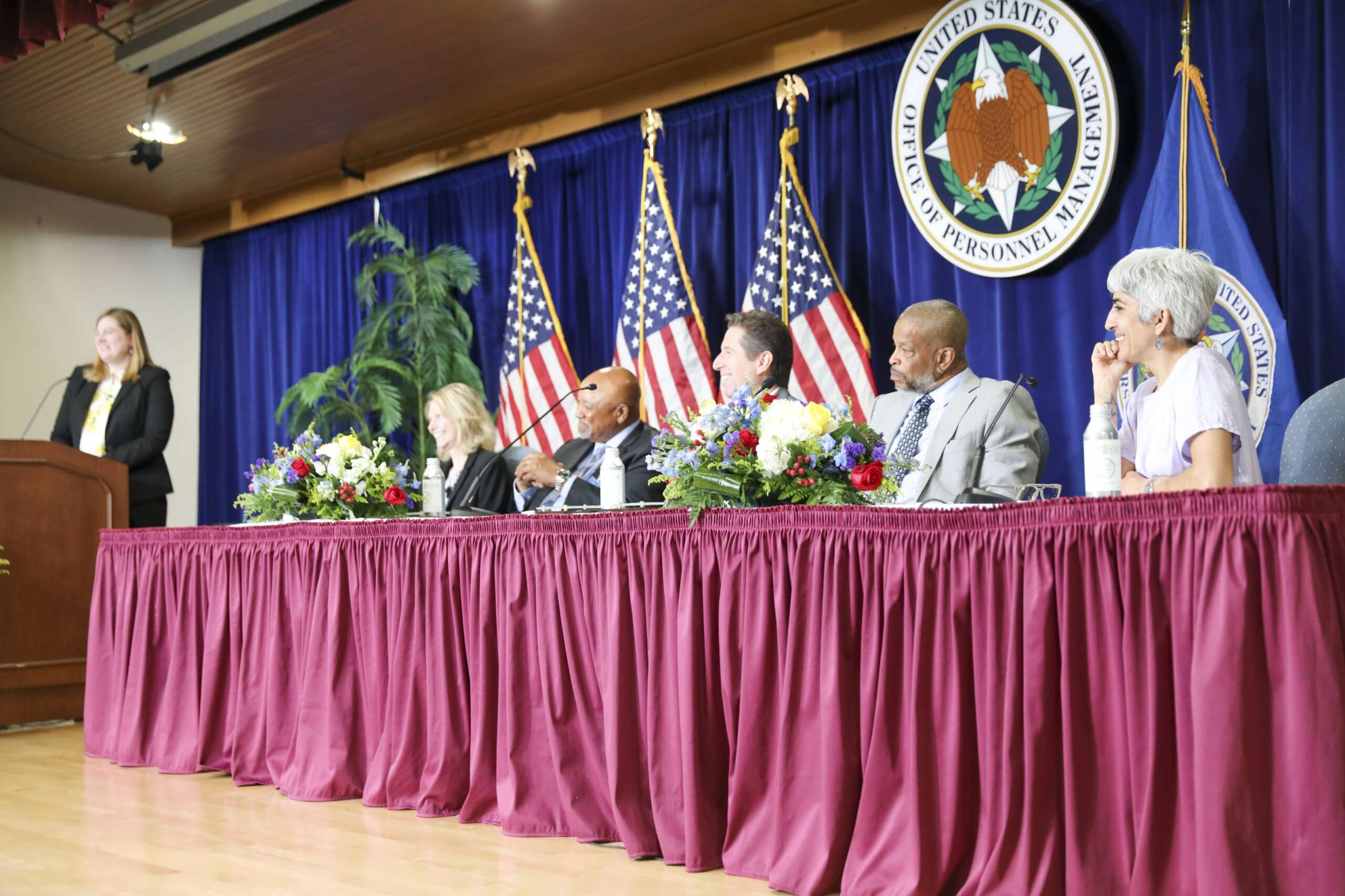 Panel discusses past and future goals for the CHCO Council at 20th anniversary celebration and awards ceremony in 2023. From left to right: former CHCO Council Executive Director Margot Conrad (at podium), VA CHCO Tracey Therit, Former Deputy Commissioner of the Social Security Administration’s Office of Human Resources Reginald Wells, former human capital leader Raymond Limon, former Department of Agriculture CHCO William Milton, Jr., former OPM Director Kiran Ahuja. (Photo courtesy of OPM, 2023)
Panel discusses past and future goals for the CHCO Council at 20th anniversary celebration and awards ceremony in 2023. From left to right: former CHCO Council Executive Director Margot Conrad (at podium), VA CHCO Tracey Therit, Former Deputy Commissioner of the Social Security Administration’s Office of Human Resources Reginald Wells, former human capital leader Raymond Limon, former Department of Agriculture CHCO William Milton, Jr., former OPM Director Kiran Ahuja. (Photo courtesy of OPM, 2023)
The new charter of the CHCO Council led to years of work during the Biden administration to bolster the use of human capital data in decision-making, as well as use more collaborative strategies for federal recruitment, such as shared certificates and pooled hiring. And leading up to new final regulations in 2024, CHCOs were also involved in informing the major overhaul of the Pathways Program.
A growing recognition of human capital’s importance
But over time, many career CHCOs have also pointed out various tensions in the federal human capital community — whether it’s how the political and career sides of the CHCO Council should interact, how the CHCO role itself should be approached, or how human capital leaders should work with the executives leading different components of an agency.
“I remember in 2012 we brought the CIOs and CHCOs together at OPM for a meeting. And it was so clear — there were some agencies where the CHCO and the CIO sat side by side. It was a relaxed relationship. But then I swear there were some others where we were introducing them for the first time,” DiMartini said. “We’ve gained a lot more respect over the last 25 years, but I still think there is a reluctance to fully grasp and understand why human capital matters.”
“CHCOs deserve to be at the table for every decision made at the agency,” DiMartini added. “Let the human capital professionals do what they do best — develop policy and provide guidance. CHCOs are important. They should be valued.”
For Conrad, the relationship between career and political leadership on the CHCO Council is an essential one. If done effectively, political leaders can elevate the voices of CHCOs and bring forward legislative proposals attempting to reform human capital in a way that’s fully informed by those who know the issues best.
“If political leadership really views the CHCOs as these senior advisors that can help them understand what’s happening on the ground and share recommendations on how to make things better, that is invaluable,” Conrad said. “CHCOs are perfectly positioned to understand their organizations, the people, the mission, where the challenge points are — and also to creatively problem-solve and figure out ways to do things better.”
The relationships on the council also depend on who’s sitting in the political seats. Throughout various administrations, some OPM and OMB leaders have been deeply involved in the council and attempted to listen to the challenges and advice of CHCOs. But other political leaders might drop in for attendance and opening remarks, then leave within the first 15 minutes of a council meeting.
“The CHCO cannot be seen as out of lockstep with leadership,” Limon said. “And when you don’t have that leadership buy-in, then that’s just going to make the CHCO’s job much more difficult, creating this sense of, who’s in charge? What are we trying to do? What are we focusing on?”
The future of CHCOs and the council
Given all the major, rapid overhauls currently underway for the federal workforce, it’s no surprise that the CHCO Council is currently operating at full force. While the council has continued to hold its regularly scheduled monthly meetings, CHCOs have also ramped up the frequency of “special sessions” of the council, figuring out how to address the massive uptick in policy implementation work over the last several months.
Colleen Heller-Stein, the current executive director of the CHCO Council, likened the pace of the rollout of Trump administration’s workforce changes to interval training for a running race.
“We have been moving at a rapid pace. But there’s not a CHCO out there who hasn’t experienced the need to implement something quickly,” Heller-Stein, formerly CHCO of the Treasury Department, said in an interview. “There are times where you really need to surge, and you are going at a much quicker pace because something needs to happen. But then there might be some downtime where you evaluate, you’re taking stock — and maybe you’re making a plan for the next surge.”
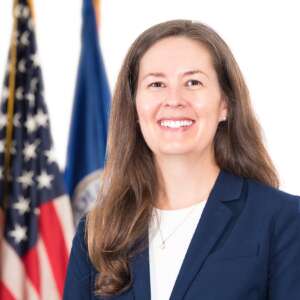 CHCO Council Executive Director Colleen Heller-Stein (Source: CHCO Council website)
CHCO Council Executive Director Colleen Heller-Stein (Source: CHCO Council website)
Heller-Stein pointed to the deferred resignation program as one effort the administration wanted to implement rather quickly — and that required the expertise of CHCOs to make it a reality.
“Things like this have happened in industry, but it was something entirely new and novel for government,” Heller-Stein said. “It’s a great example of the CHCOs coming together and really partnering with OPM to figure out how to implement it. We really relied on the CHCOs’ experience and knowledge specific to the federal sector to think that through.”
Despite all of the changes to the federal workforce, some of the long-term human capital goals for the council also remain the same, like figuring out more efficient hiring methods, and using workforce data to make informed, strategic decisions, according to Heller-Stein. Moving forward, she said she’s looking forward to the release of the President’s Management Agenda, which CHCOs have historically been heavily involved with on the implementation side.
At the same time, though, others in the human capital space have said they believe the Trump administration’s changes to the workforce will mark a negative turning point for recruitment and retention, both now and in the future.
“In any agency, how you treat your people, how you hire them, how you train them, how you onboard and offboard them, that makes a difference. We are making an impression on the next generation of civil servants right now — and it’s not a very good one,” DiMartini said. “But I’m hoping, through trial and error over the next few months, we can all come back together as career executives and find a way to improve the experience.”
And in some ways, Sen. Voinovich’s perspectives on the pervasive challenges of federal human capital are more relevant now than they ever have been.
“How can we ensure that federal workforce downsizing is managed strategically to ensure that our need for experienced, skilled employees is not compromised and the government’s ability to provide quality services is maintained and even enhanced?” Voinovich wrote in 2000. “For example, I suspect that, in some instances, the employees most likely to take buy-outs are those the federal government can least afford to lose.”
The post How human capital got a seat at the federal leadership table first appeared on Federal News Network.
Politics
Musk Has Gone Quiet About the Launch of His ‘America Party’ — Here’s What We Know

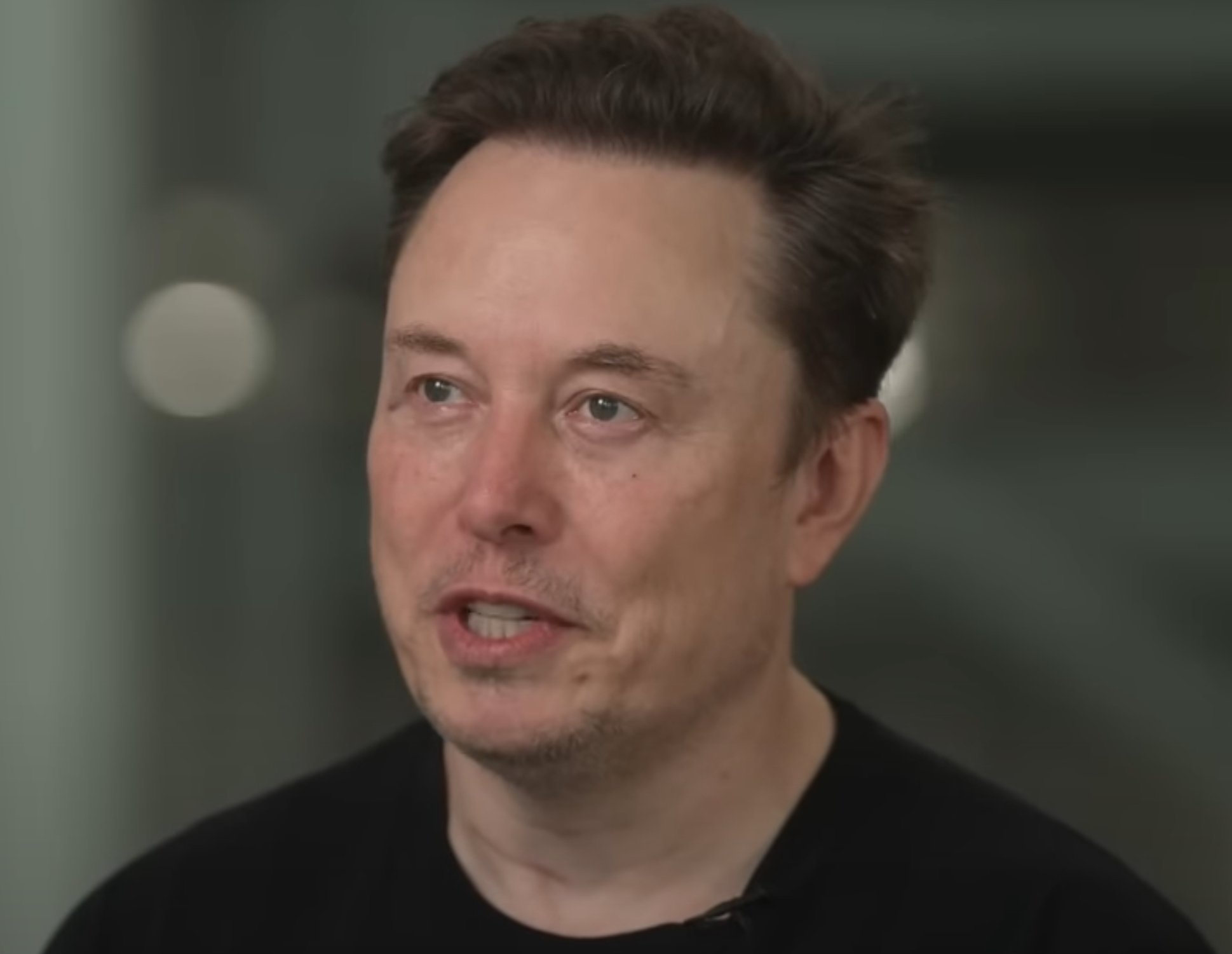
Maybe Elon Musk is more interested in planets than politics.
The mega-billionaire founder of Tesla, owner of X, and the genius behind the pioneering company SpaceX caused a huge stir in early July when he announced the birth of a new third party on the American political scene.
The question now is, whatever became of that?
Musk first broached the subject in a July 4 post on X when he launched a poll to find out what his followers thought. The results weren’t even close.
By a factor of 2 to 1, you want a new political party and you shall have it!
When it comes to bankrupting our country with waste & graft, we live in a one-party system, not a democracy.
Today, the America Party is formed to give you back your freedom. https://t.co/9K8AD04QQN
— Elon Musk (@elonmusk) July 5, 2025
“By a factor of 2 to 1, you want a new political party and you shall have it!” Musk wrote in a July 5 post.
“Today, the America Party is formed to give you back your freedom.”
Naturally, the post caused a splash.
Elon Musk is one of the few names in politics that can even come close to competing with the star power of President Donald Trump. So the idea that he could be mounting an actual challenge to Trump’s Republican Party would have been news indeed.
But as The Daily Caller White House correspondent Reagan Reese wrote in an article published Monday, there appears to be nothing in the way of follow-through coming yet.
“Musk hasn’t even mentioned the effort in over a month, and insiders told the Daily Caller that it seems Musk has begun to realize just how difficult what he pledged to do would be,” Reese wrote.
At the time of Musk’s announcement, Trump branded the idea of a third party “ridiculous.”
NEW: Trump Responds to Elon Musk Starting a Third Party When Asked By a Reporter: “Third parties have never really worked. So he can have fun with it, but I think it’s ridiculous.” pic.twitter.com/qTARvvE1Jx
— Chuck Callesto (@ChuckCallesto) July 6, 2025
Musk, of course, has other things on his plate besides politics.
As USA Today reported last week, Musk’s SpaceX could be nearing a new test flight for its Starship rocket, a 400-foot spacecraft the newspaper called “crucial” to future space ambitions, for Musk and the country as a whole.
Musk is a very public booster of manned trips to Mars — extraterrestrial exploration is vital “for the long-term survival of civilization,” he said, USA Today reported.
Humanity is essentially faced with the prospect of branching out or dying out.
One path means “we stay on Earth forever and then there will be some sort of eventual extinction event,” he wrote in a 2017 paper published by the journal New Space.
According to the electronics news-centric website CNET, Musk told the SXSW festival in Austin, Texas, in 2013 that he wants to die on Mars — “just not on impact.”
There are also very earthly concerns for Musk to consider about starting a party that would compete almost exclusively with Republicans for support.
(Besides Musk’s famously libertarian inclinations — free speech, gun rights, etc. — his popularity among liberals is so low it can be measured in the number of Tesla vehicles damaged and dealerships attacked by leftists.)
According to Reese’s report, a former Department of Government Efficiency consultant who launched a political action committee specifically to counter the threat of a Musk third party said Musk has realized that helping Democrats might not be so helpful to his own interests.
“Make no mistake, there is a real threat to both Elon and to his businesses if the Democrats were to regain control,” James Fishback, CEO of the Arizona investment firm Azoria, told Reese.
“That’s a message that I shared privately with Tesla executives, and that may have been part of the reason why he attenuated his positioning on that.”
Musk can be unpredictable, of course. He’s a generational genius, and geniuses make their own decisions and forge their own paths.
But for now, at least, it appears his third party is going to stay in the background of the political stage.
This article appeared originally on The Western Journal.
The post Musk Has Gone Quiet About the Launch of His ‘America Party’ — Here’s What We Know appeared first on The Gateway Pundit.
Politics
Chinese Ships Collide: Karmic Payback for Years of Bullying the Philippine Coast Guard
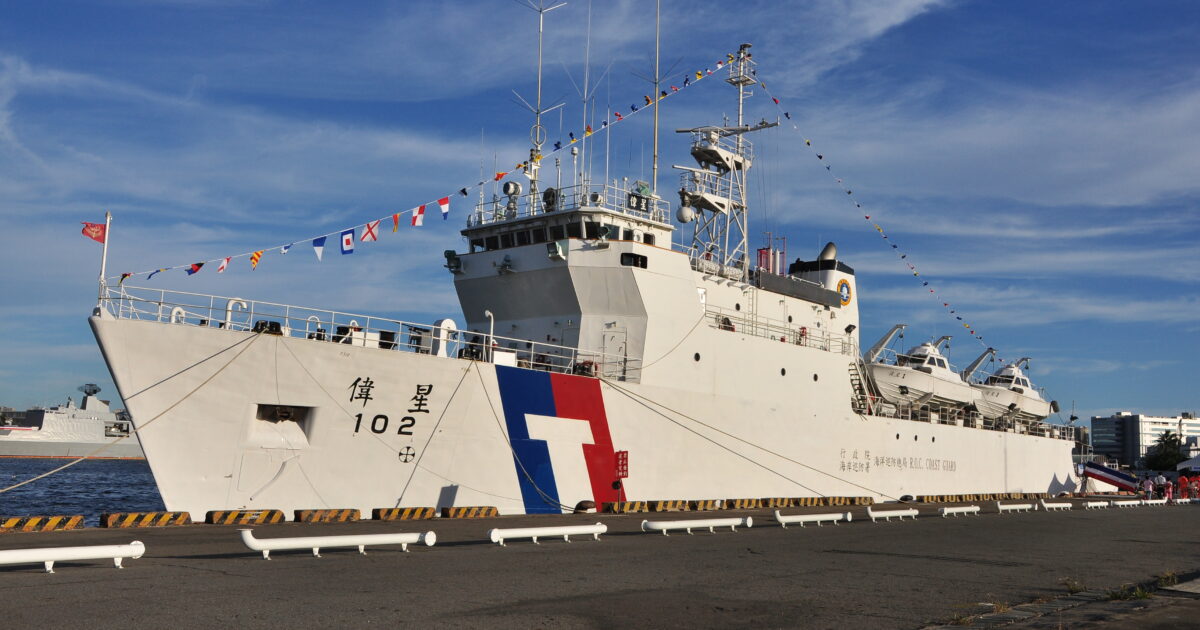
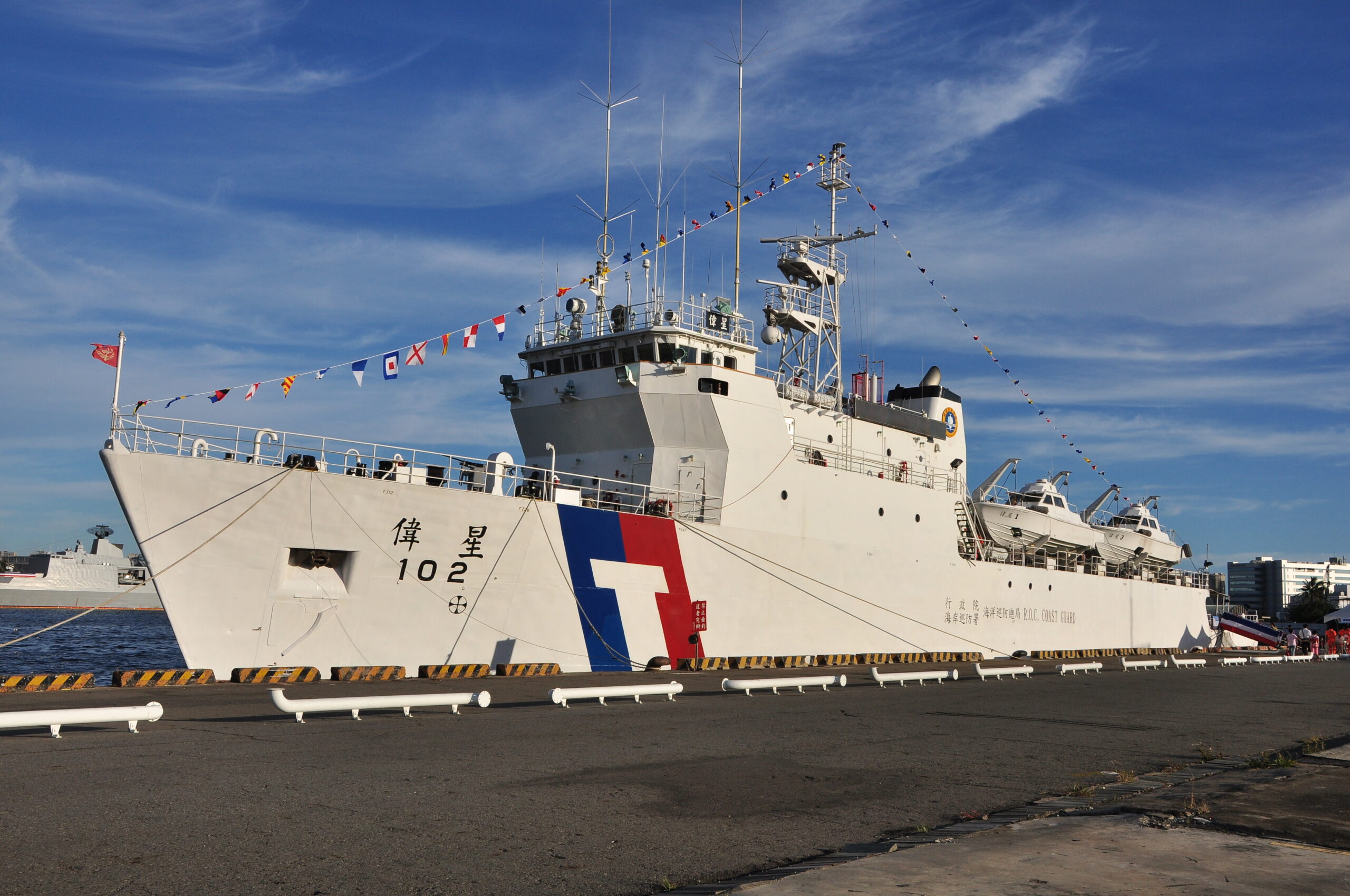 RudolphChen, CC BY-SA 3.0 <https://creativecommons.org/licenses/by-sa/3.0>, via Wikimedia Commons
RudolphChen, CC BY-SA 3.0 <https://creativecommons.org/licenses/by-sa/3.0>, via Wikimedia Commons
On an ongoing basis, the Chinese Coast Guard has harassed and intimidated Philippine Coast Guard and fishing vessels in the South China Sea. China claims almost the entire sea, while the Permanent Court of Arbitration has rejected China’s claims. As the Philippine ships and vessels continues to use territory which the world recognizes as belonging to the Philippines, China has historically used bully tactics, blocking, ramming, and damaging Philippine vessels or shooting them with high powered water cannons. This week, China was dished some karmic justice when two of its bully ships collided, rendering one of them on seaworthy.
This increased aggression by China is one of the primary reasons why the US Navy conducts freedom of navigation patrols in the region.
On Monday, August 11, 2025, two Chinese vessels collided while pursuing Philippine Coast Guard ships near Scarborough Shoal in the South China Sea. The Chinese Coast Guard cutter CCG 3104 struck the PLA Navy guided-missile destroyer Guilin (hull number 164) a botched blockade attempt.
The clash occurred as Philippine Coast Guard vessels BRP Teresa Magbanua and BRP Suluan escorted the fishing vessel MV Pamamalakaya and 35 local fishing boats as part of Manila’s Kadiwa Operation, which delivers fuel and supplies to Filipino fishermen operating in the country’s western exclusive economic zone.
Philippine Coast Guard spokesman Commodore Jay Tarriela said CCG 3104, while chasing the BRP Suluan at high speed, attempted a risky maneuver from the vessel’s starboard quarter. The cutter’s movement caused it to ram into the Guilin, which was approaching from the other side. Analysts believe the Chinese ships were trying to “sandwich” the Philippine cutter, forcing it into the path of a close-range water cannon blast. Poor coordination turned the maneuver into a self-inflicted collision.
The impact left CCG 3104 “unseaworthy,” with significant damage to its bow and forecastle. The Chinese crew did not respond to the Philippine ship’s offer of assistance, and it remains unclear if there were any injuries.
The involvement of the Chinese Navy destroyer Guilin in the Scarborough Shoal collision was considered highly unusual and “overkill” by analysts. PLA Navy warships typically remain “over the horizon” and avoid direct engagement, leaving such confrontations to the Chinese Coast Guard. This made the August 11 incident one of the most severe encounters between Chinese forces and the Philippines, highlighting the escalating tensions in the South China Sea.
Scarborough Shoal has been a persistent flashpoint since China seized it from the Philippines in 2012. Since then, Beijing has waged a steady campaign of harassment against Philippine civilian and government vessels, which has intensified in recent years. In February 2023, a Chinese Coast Guard vessel used a military-grade laser against a 44-meter Philippine Coast Guard ship during a resupply mission.
In March 2024, Chinese ships deployed water cannons on Philippine vessels, shattering a windshield and injuring crew members. The following month, three Chinese cutters rammed and blasted Philippine patrol boats with water cannons near Scarborough Shoal, while others threatened Filipino fishermen at Iroquois Reef. In January 2025, multiple Chinese vessels made aggressive maneuvers toward Philippine fisheries boats, forcing the suspension of a scientific survey.
Beijing justifies these actions through its “nine-dash line” claim, which asserts Chinese historical rights over roughly 90 percent of the South China Sea. The claim is based on a 1947 map created by the Nationalist government and later adopted by the Communist regime, citing historical records dating back to the Han Dynasty. Despite a 2016 international arbitration ruling rejecting the nine-dash line as having “no legal basis,” China has ignored the decision and continued to enforce its claims.
By enforcing the nine-dash line, Beijing seeks to transform these international waters into de facto sovereign territory in a process experts call “maritime territorialisation.”
Strategically, the South China Sea is a vital artery for global trade, with $3.36 trillion worth of goods passing through annually, including 80 percent of China’s energy imports. The waters are also rich in fishing grounds and contain large reserves of oil and natural gas.
Ironically, China is a signatory to the United Nations Convention on the Law of the Sea (UNCLOS), while the United States is not. Yet it is the U.S. that serves as the principal enforcer of the law, and China that stands as its principal violator.
The post Chinese Ships Collide: Karmic Payback for Years of Bullying the Philippine Coast Guard appeared first on The Gateway Pundit.
Politics
$50 Million Bounty on Nicolás Maduro: A New Chapter in Counter-Terror Strategy.
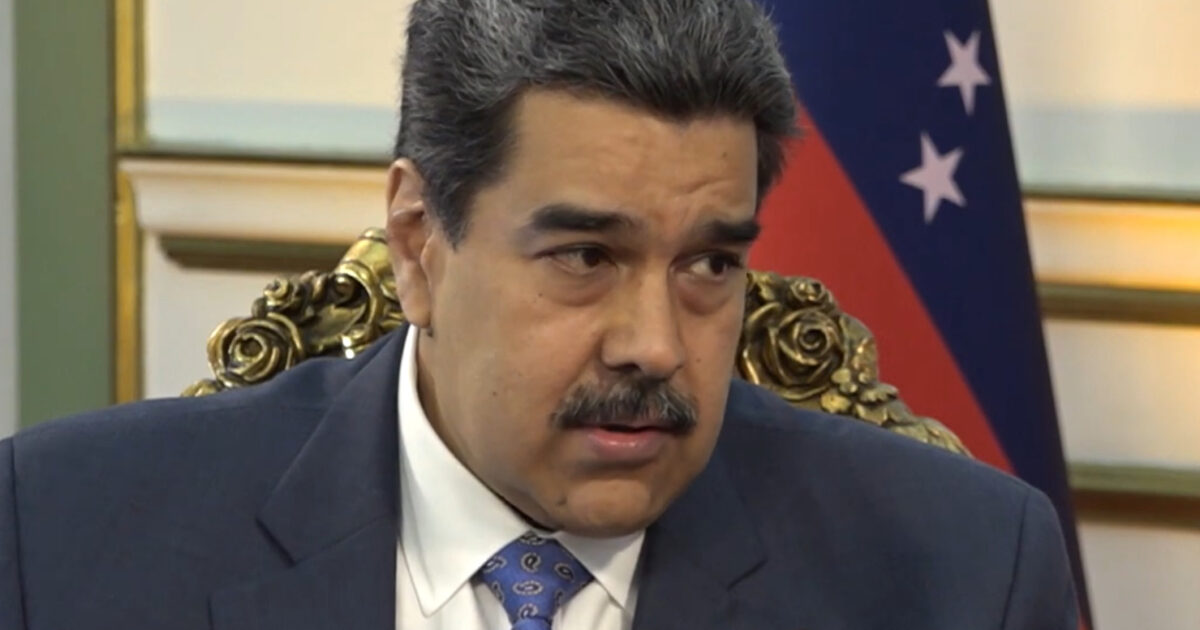
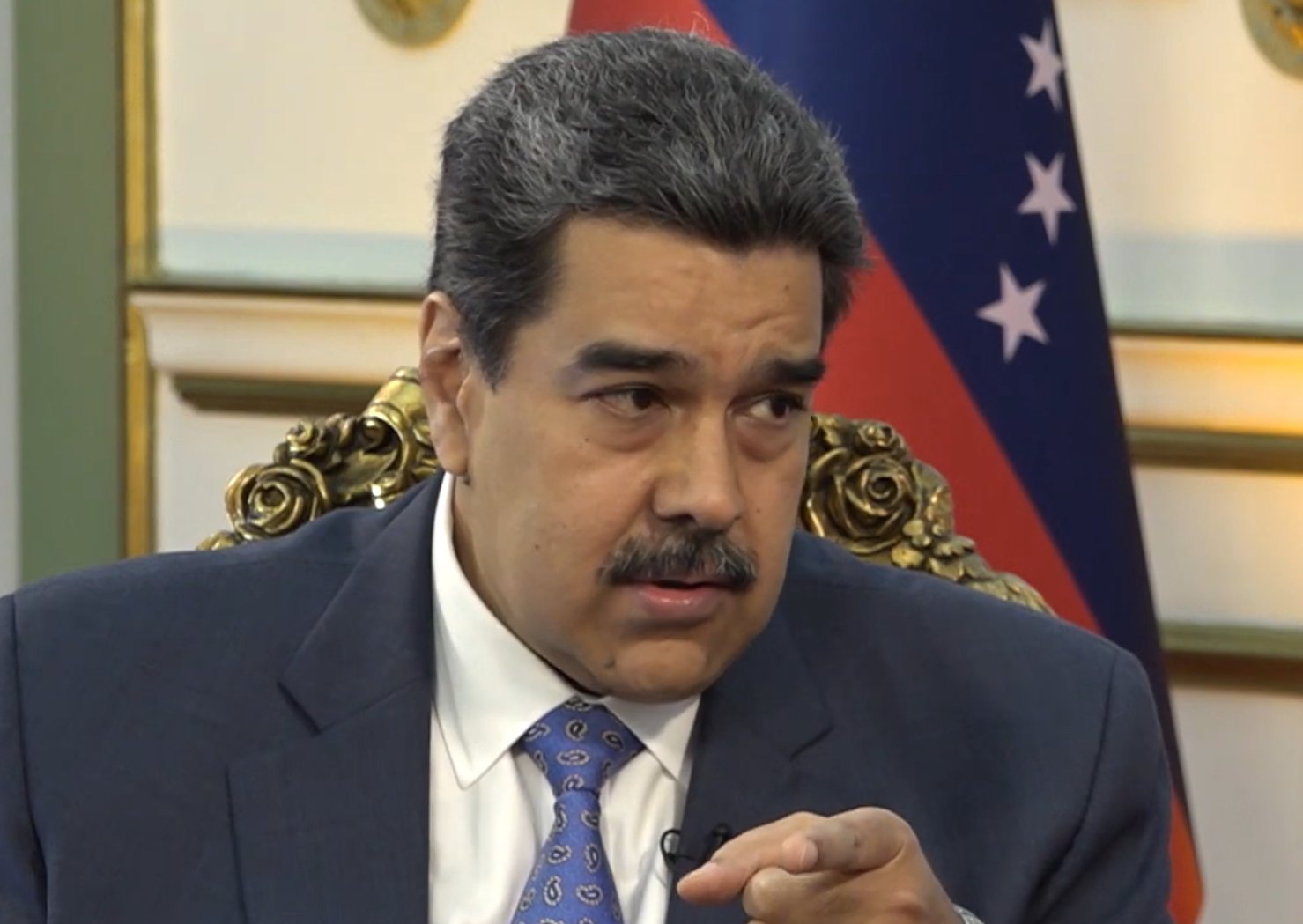
This is a Gateway Hispanic article.
The post $50 Million Bounty on Nicolás Maduro: A New Chapter in Counter-Terror Strategy. appeared first on The Gateway Pundit.
-

 Entertainment5 months ago
Entertainment5 months agoNew Kid and Family Movies in 2025: Calendar of Release Dates (Updating)
-
Tech5 months ago
The best sexting apps in 2025
-

 Tech6 months ago
Tech6 months agoEvery potential TikTok buyer we know about
-
Tech6 months ago
iOS 18.4 developer beta released — heres what you can expect
-

 Politics6 months ago
Politics6 months agoDOGE-ing toward the best Department of Defense ever
-

 Tech6 months ago
Tech6 months agoAre You an RSSMasher?
-

 Politics6 months ago
Politics6 months agoToxic RINO Susan Collins Is a “NO” on Kash Patel, Trashes Him Ahead of Confirmation Vote
-
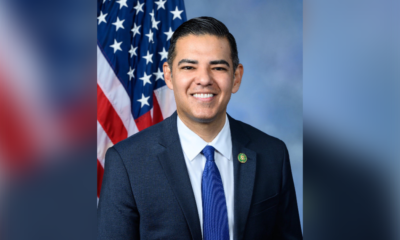
 Politics6 months ago
Politics6 months agoAfter Targeting Chuck Schumer, Acting DC US Attorney Ed Martin Expands ‘Operation Whirlwind’ to Investigate Democrat Rep. Robert Garcia for Calling for “Actual Weapons” Against Elon Musk





